Mid-Season
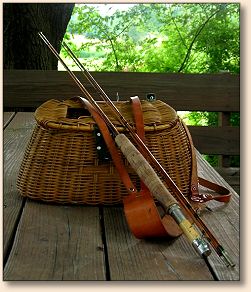
By Dave Pearson, PA
I got on the water for a few hours late Saturday afternoon.
The goal was to bring home a couple of trout for dinner. Bear
in mind that I didn't actually promise trout for dinner; that
would have shown a certain lack of humility which the fishing
gods would have taken as a personal affront guaranteeing a
hook-free day for the fish and the big goose egg for me. No,
I merely said if I was lucky enough to catch a few, and they
were of edible size, I would bring home a couple. If not, I'd
stop at the market on my way home for some flounder or something.
Maybe spaghetti.
So, I brought my wicker creel. And since it looks so good with
the creel, I packed my bamboo 4 weight. Who am I trying to kid?
I would have brought the boo anyway, creel or no, because it suits
me and suits this particular stream. But the combination of wicker
and bamboo is a classic and it felt right. It was too hot for the
tweed jacket.
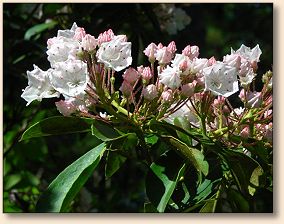
I got on to the water at about 4pm. The stream was running at
summertime levels, that is, low. Really low. We really need some
rain. I just hoped the water wasn't running at summertime
temperatures. I got out the thermometer and checked. Nope.
Running at a cool 68 degrees. So the trout should be in shade
or up toward the heads of the pools; preferably both. Better
yet, just downstream from a spring in the shade at the head of
a pool. Anything to lower the temperature a couple of degrees
and increase the dissolved oxygen in the water. They wouldn't
have gone far; that will come later in the season when the heat
is unbearable and the dissolved oxygen content of the water is
nil. Then the trout will travel upstream or up the tributaries
to more comfortable climes where it is easier to breathe. But
as long as the water temperature drops to the high 50's to mid
60's at night, the fish will be in the same stretch of water
they were in earlier in the season; just in the coolest parts
of it.
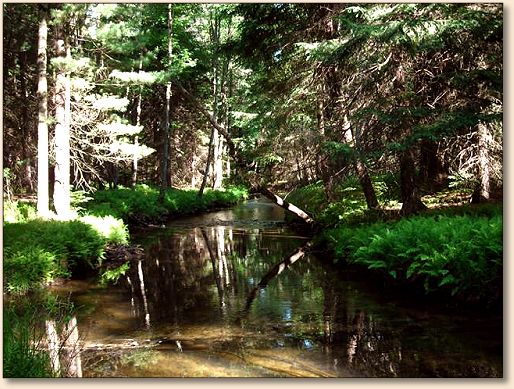
Just downstream from where I entered the water the stream bends
to the left. There is a small riff at the beginning of the bend
which sweeps the water to an undercut bank. I wouldn't call this
deep water, but it's deeper than anywhere else in the small pool
and the small riff is delivering a good shot of oxygen to the
undercut.
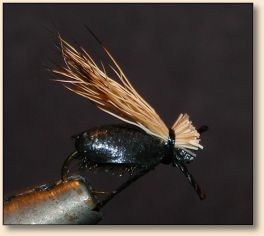
I eased back from the stream, walked well below the pool, and
crept within casting range. Low, clear water means far and fine
casting. I tied on a small beetle, size 16, and popped it to the
head of the pool. It took a short ride down the seam to the
undercut bank and BAM it was pulled under the water like it was
sucked down a drain.
The brown was larger than I expected and I toyed with the idea
of releasing it in favor of a smaller fish; but too much of that
and I'd be eating spaghetti for dinner.
I slit a gill and held the fish in the water. The water washed
red as the fish lost consciousness, then life. I cleaned the fish
and put it in my basket. I also put in a handful of ferns to help
the air in the basket circulate and keep the fish cool. Even if
this practice had no practical purpose, I would have done it
anyway. I really like the smell.
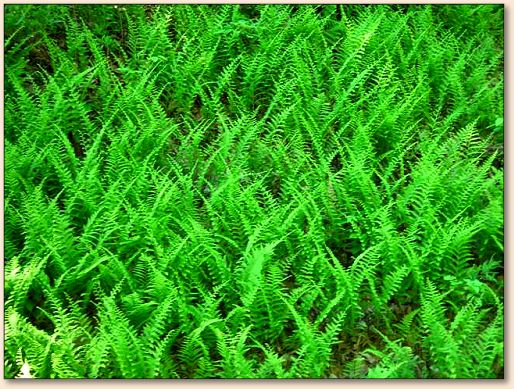
I caught a second fish in short order, a wee bit smaller than the
first. He joined his companion in the wicker basket. Dinner was
secured and my place as the great white hunter remained intact.
I thanked the fishing gods and stopped to rework my leader.
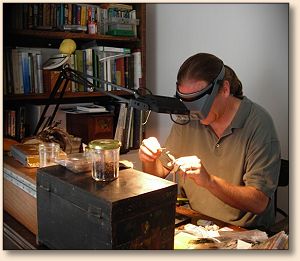
I used to buy tapered leaders and they worked well enough. They
got the fly a good distance from the fly line and I was able to
get a pretty good drag-free float with them. The main problem
I had was I managed to go through them at a really good clip.
I was as (as they say) mad as a hornet when I discovered that
Orvis tapered leaders had about 3 inches of tippet on them.
Then I found out you were supposed to tie on a length of tippet
to brand new tapered leaders fresh out of the packet. The leaders
lasted longer. Then I furled my own. These lasted forever. And
they worked fine.
But never being one to leave well enough alone, I started fooling
around building my own leaders of mono. I'm using a modified Joe
Humphrey's formula. 13 ½ inches of .017, 12 inches of .015, 12
inches of .013, 9 inches of.011, 9 inches of 2x, 10 inches of 4x,
and 20-22 inches of 4x. This is the basic formula. If I want to
taper to 5x, I'll chop the 4x piece to 11 or 12 inches and add
about 2 feet of 5x. If that collapses when I cast I'll lengthen
the 4x and shorten the 5x. If I need 6x, I'll chop the 5x and
add the 6x, and so on. The 6x tippet was a bit frayed by those
two fish, so I put on a new section, tied on a new beetle and
headed upstream.

I took a few more fish before calling it a day and just to satiate
my curiosity, at each spot where I took fish, I also took the water
temperature. Wouldn't you know it? At each spot that yielded trout,
the water was 2 to 4 degrees cooler than the rest of the stream. ~ Dave - (black gnat)
About Dave:
Dave Pearson lives in Lewisburg, Pennsylvania with his
loving wife, Gillian, and two dogs, Casey and Booboo.
His passion is small mountain streams. He teaches guitar
for a living. You may contact Dave at:
pdewey2@aol.com
Hemlock Headwaters Archives
|

